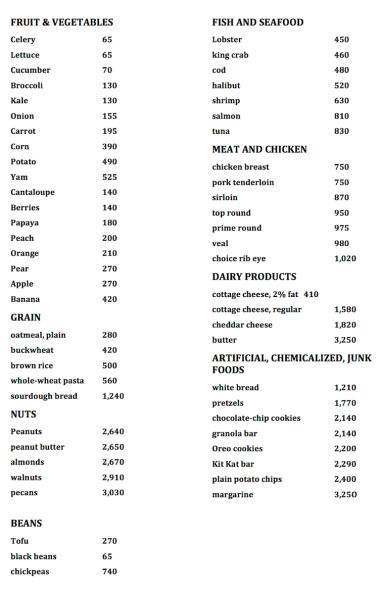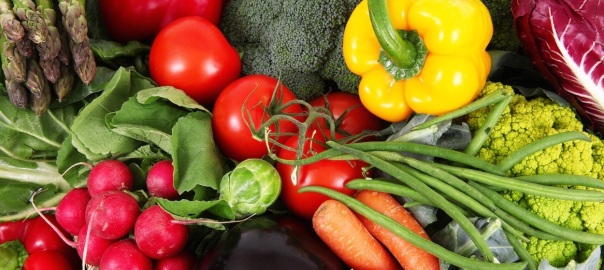The Volumetric Diet is the brainchild of nutritionist Barbara Rolls, Ph.D., and is based on her twenty years plus of studies on people dietary patterns and eating behavior. In her observations she took noticed of the fact that people over a few days tend to eat the same weight of food, without really knowing the amount of calories they ingest.
I use to believe in power meals, both dinners or lunches. Small, protein packed meals, in order to keep fit and mantain energy levels. Inevitably a few hours later, I would need to have more food, a snack – usually a sugar treat – in order to get to the next meal or to not fall asleep on my computer. Understanding volumetric theory is very helpful in changing the way we build meal habits, opting in favor of a sense of fullness with substantially nutriotious choices, rather than for unfulfilling meals that inevitably promote cravings.
In the Volumetric dietary system, in order to loose weight, a person needs to just lower the caloric value of the portions while maintaining the same amount of food. The diet design is to make you full, because when given a choice, people choose to eat more. Eat all you want, but think about the calorie density of food: people
fill more satisfied when eating more food with lower caloric content. People fill full not because the volume of food, but because of the amount of calories they ingest.
Eating the Volumetric way, while increasing water and fiber in the daily food intake, a person will feel full, but because of the lower intake of calories, weight loss will occur. The focus of this diet is on eating, rather than deprivation.
Calorie density is the number of calories per pound for each food. Notice that CD is lowest in unprocessed plant foods.
There no forbidden foods according to the Volumetrics diet, but the accent is on avoiding fatty foods, fried foods and sweets. Another suggestion is to avoid
Research has shown that when people eat high-water content foods such as a green salad with a lot of vegetables or soup, they eat less food. By filling up with
dried food, such as crackers, pretzels or popcorn, because they are higher in calories and do not provide much satiety. Specific tips are offered in Volumetrics on how to avoid high energy density food and lower caloric intake. For example, choosing a sweet snack, opt for grapes rather than raisins. Two cups of grapes, contains the equivalent amount of calories of a ¼ cup of raisins. Choosing grapes is a better Volumetrics choice, because a person would most likely feel full due to the amount of water contained in the grapes. In fact, according to Volumetrics, food containing more water and fiber, such as fruits and vegetables, are healthier because have a lower energy density, or number of calories for specific amount of food. Food with high calorie density includes sugary and fatty foods, like potato chips and cookies.a plant-based diet, a person can balance blood sugar and avoid cravings. This method might help naturally “crowd out” less favorable food choices, thus helping to keep calorie consumption low to maintain a healthy weight.

Volumetrics offers detailed guidance on nutrient and fluid intake, as well as physical activity. In the 326-page publication ‘Volumetrics: Feel Full on Fewer Calories’, published in 2000, the authors make the following weight management recommendations:
-Calories (Energy): Reduce usual intake by 500 to 1,000 calories per day, depending on weight-loss goals. This practice should lead to a healthy weight loss of 1 to 2 pounds per week.
-Fat: Limit to 20 to 30% of total calories and look for foods reduced in fat and calories.
-Carbohydrates: Carbohydrates should comprise 55% or more of total calories; it’s preferable to choose carbohydrates from whole grains, vegetables, and fruits because they are more satiating.
-Fiber: Eat at least 20 to 30 grams per day from whole grains, fiber-rich breakfast cereals, and whole fruits and vegetables, as opposed to fruit juices. Fiber is key for lowering energy (calorie) density as well as increasing overall satiety.
-Sugar: Choose a diet moderate in added sugars. Dr. Rolls suggests lowering intake of sodas and other sugary drinks because these foods add calories without satiety. Use small amounts of sugar to make low-energy, nutritious foods tastier.
-Protein: About 15% of daily calories, or 0.4 grams per pound of body weight, should come from protein foods. Beans, low-fat fish, poultry without skin, and lean meats are recommended as the most satiating choices. Adequate amounts of protein are needed to prevent muscle loss and maintain metabolism.
-Water: Water consumption is a key component of the Volumetrics eating plan. It recommends women drink at least 9 cups daily, whereas men should consume 12 cups daily. Water can come from foods or beverages and should replace sugary drinks in the diet.
-Exercise: To manage weight, dieters should also get at least 30 minutes of moderate-intensity exercise on most, if not all, days of the week. Resistance training should be included twice a week. Dr. Rolls recommends walking at 3 to 4 miles per hour as an ideal choice for most people, even those who have substantial amounts of weight to lose. Dieters should also focus on reducing the overall amount of time they spend in sedentary pursuits, such as television watching, and increase physical activity by gardening, house cleaning, or other non-sedentary activities.*

Calorie density is also the same approach to dietary principles outlined in ‘The Pritikin Principle: The Calorie Density Solution’ by Robert Pritikin. The Volumetrics approach is in line with the Pritikin diet, developed in the 1960’s by Nathan Pritikin. The diet was quite radical for its time, but most of his principles have since been incorporated into advice given on how to reduce the risk of developing cardiovascular disease by mainstream organizations such as the American Heart Association.
The newest version of the Pritikin Plan calls for avoiding foods that are calorie dense. These are foods that pack a lot of calories into a small volume of food (e.g. oils, cookies, cream cheese). Instead, Plan followers are encouraged to choose low-calorie foods that provide a lot of bulk (e.g. broccoli, carrots, dried beans). This way, dieters can eat a lot of food and feel full without taking in a lot of calories. The plan does not limit the amount of healthy fruits and vegetables a person can eat, and it suggests to divide food intake among five or six smaller meals during the day.
In the Volumetrics diet though, guidelines for consumption of carbohydrates and protein are slightly lower in proportion to total calories than those in the principles of the Pritikin diet. In addition, the Volumetrics allows for more fat, in line with today’s dietary approaches. In contrast with Pritikin, Volumetrics also allows for more variety, with a more liberal allowance of lo-fat poultry and meat, which increases the likelihood to adherence to a diet that decreases caloric consumption.**
Energy Density = calories/pound
Calorie density is the number of calories in a given weight of food and the Pritikin Principle is based on calories per pound
CALORIE DENSITY
Excerpted from The Pritikin Principle: The Calorie Density Solution by Robert Pritikin

* Diet.com
**Nutritional and Clinical Management of Chronic Conditions and Diseases
edited by Felix Bronne
